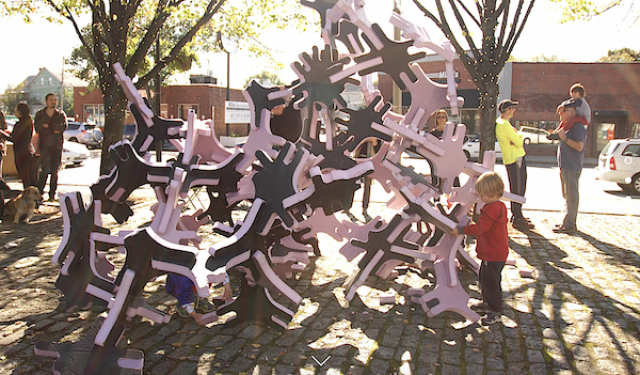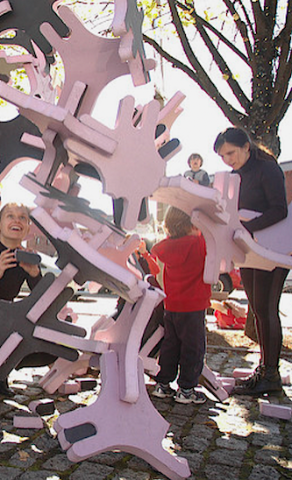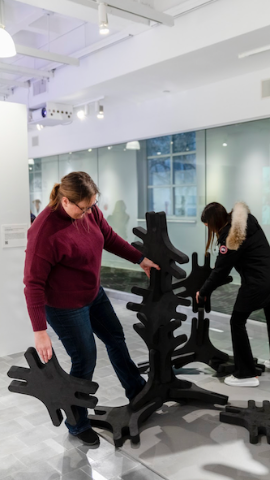Department of Play
New Urban Planning Paradigm
By: Mark Faveremann - May 27, 2023
Participatory, small-scale planning is a powerful step forward because it doesn’t pay lip service to cliches about “listening to the community.”
Frequently descriptive, often colorful, and occasionally thoughtful buzz terms like placemaking, urban metabolism, densification, and street activation have become a routine part of our urban planning vernacular. A currently used technical term is tactical urbanism, which describes quick, temporary, or short-term interventions that seek to improve neighborhoods or common spaces through grassroots initiatives. Examples include pop-up festivals, parklets, or temporary public participatory art installations. Decorated stop and yield signs as well as altered billboards are guerilla versions of this.
Another, and quite appealing, approach to encouraging healthy and happy experiences has been developed. The idea of interactive play is about creatively strengthening the connection between the community and urban environment. Play can be defined as the opposite of work. But is it? Or rather, should it be? For years, various high-tech companies have given their employees tools to play with while at work. The rationale is that this is a way for employees to relax, refocus, to indulge in creative interaction, and even build shared community.
A related understanding of play was born in the ’60s and early ’70s. It was initially classified as a counter-cultural activity, perceived as a bit revolutionary, even subversive. A half century later it has inspired a focused concept, which sees play as a community outreach mechanism for urban planning. The brainchild of Kate Bulag, a PhD candidate at Harvard’s Graduate School of Design, the Department of Play is a Boston-based collective that creates temporary play zones in public spaces. Here people can step out of the everyday and play out various imagined or aspirational worlds. It is non-competitive, but participating in the “fun” comes off as a “winning” strategy for all involved.
The value of play in this approach is that it encourages participants to envision alternative futures, share life experiences and personal knowledge while collaboratively creating and shaping artifacts. Every play zone encourages new learning and relationships. staged. Drawing on a hands-on approach that calls for working with multiple partners, Bulag and members of the team treat play as a research framework, a way to investigate how public spaces can be made in the context of rapidly developing urban privatization.
Inspired by urbanism studies and an appetite for science fiction, Katarzyna (Kate) Balug’s planning practice for the Department of Play has been influenced — from research to curation — by performance and installation art.
An example of Department of Play’s approach was recently on display at Northeastern University’s Gallery 360’s exhibition At Play. The collective views its mission as fostering group discovery and involvement in the thoughtful (playful?) envisioning of an evolving urban environment. Their process involves building transitory, compelling, and even aspirational fictional worlds in public settings. The result is to nurture collective empathy through imaginative cooperation; the result is a positive, community-building experience among the participants.
The virtue of the approach is obvious. Play is a lot more fun than dealing with the tedium of bureaucratic meetings, with their strict agendas. Traditional government planning processes — often led by “experts” — offer limited opportunities for participation. The notion of play opens up communication in a group by inviting less formal relationships. The disenfranchised can feel comfortable enough to join in. Play is a common language, one where people can share unconventional knowledge and work out new perspectives. To the collective, play is “a medium for collective creativity and a tool to forge horizontal social relations.”
The process is easy enough. The Department of Play stages what it calls play zones in unused, underused, or empty community spaces. These include vacant lots, public transit stations, sidewalks, even parking lots. The selection often focuses on spaces that serve as urban “border” areas that limit access or movement through the city. Collaboration with partners allows hands-on play to be effective in a number of ways, particularly as an investigative research framework. Cities are inevitably evolving, so there is a need to come up with alternative visions of architecture and urban planning by making the landscape more understandable and accessible. In a most comfortable way, the Department of Play engages individuals to rethink, rework, and reimagine the present and future of cities.
In her research, founder Kate Bulag studies how art objects and built environments produced during a certain period reflect the possibilities of the time. She argues that looking at place as a mirror upends conventional wisdom. For example, her PhD dissertation examines ’60s inflatable architectural structures — in the context of the existential implications of the Space Race between Russia and America. Her own art practice — expressed through Department of Play — foments collaboration that is about transformation: everyday urban landscapes undergo an experimental makeover into what are hoped to be improved public spaces, with potential for revivifying experiences.
From the start, Bulag and Department of Play co-founder anthropologist Maria Vidart-Delgado were interested in what they call the “border zones” of the city. These are divisions “that often go unspoken but are felt by the people.” Many large cities have these areas that express these polarities, not just in terms of race and socio-economical disadvantages, but dictated by historical events. “Often these are either points of tension between groups or they are just ignored,” explains Bulag.
Politically, the Department of Play is a way to gather community members together to address important civic issues in a way that is fun and involving, “not in a tense community meeting format where everyone comes with a proposed agenda.” Balug say, “We’re playing together in a way that addresses these issues that we’re all experiencing.”
Balug and Vidart-Delgado have referred to Department of Play as a “lost city department,” which frames urban development as a process should be welcoming to all residents. The invitation to play is a powerful one because it draws on a common language. People are encouraged to share life experiences and knowledge, envision alternate futures, and collaboratively create.
It is time to shift away from the traditional authoritarian planning model. Participatory, small-scale planning is a powerful step forward because it doesn’t pay lip service to cliches about “listening to the community”; this is public input that will tap into the know how and enthusiasm of the less affluent and less established residents. The Development of Play is on track to create something new: a more connected, more relevant, and more satisfactory urban planning paradigm.
Courtesy of Arts Fuse



